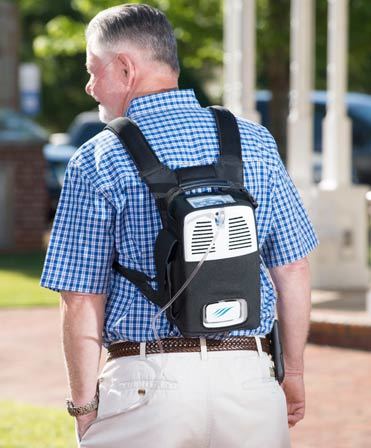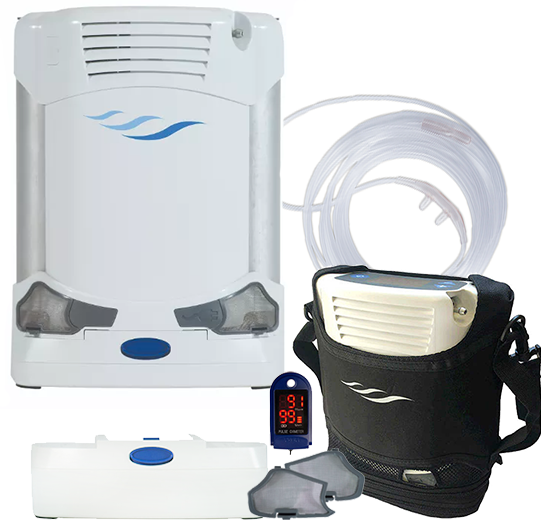The Facts About Portable Oxygen Concentrators Uncovered
Wiki Article
The Facts About Portable Oxygen Concentrators Revealed
Table of ContentsThe Buzz on Portable Oxygen ConcentratorsUnknown Facts About Portable Oxygen ConcentratorsAbout Portable Oxygen ConcentratorsWhat Does Portable Oxygen Concentrators Mean?
Fixed oxygen concentrators were once the criterion, yet these containers might weigh 50 pounds and were extremely difficult (Portable Oxygen Concentrators). Currently, portable oxygen concentrators do the job, and they can match a purse or handbag! The only thing you must keep in mind is that mobile concentrators have extra limited oxygen distribution capacitiesThere are two major kinds of portable oxygen concentrators: pulse dosage and continuous circulation. As the name suggests, pulse dose concentrators give oxygen periodically, just turning on when you inhale. This type of gadget is typically suggested for COPD clients with minimal oxygen needs, as the amount of O2 that a pulse dose concentrator can provide is relatively reduced.
This tool can provide up to 3,000 m, L of oxygen every minute, while pulse dose gadgets often tend to top out at 1250 m, L. Continuous circulation gadgets are the go-to for a lot of COPD people, as they're optimal for people that need two to five liters of oxygen a minute.
Since you have this guide to the various kinds of portable oxygen equipments, choose the ideal tool with the assistance of your physician. You can discover our blog sites to read more regarding the types of portable oxygen readily available and our other products, like tubes and cannulas. Or you can call us straight with any specific inquiries you could have.
Portable Oxygen Concentrators - Truths
We wondered just how well these mobile oxygen concentrators would certainly function in hospitals. POC concentrators raise the percentage of oxygen in ambient air people breathe in, whenever they need an increase.When it concerns mobile oxygen therapy, there are 2 major alternatives for distribution. These are portable oxygen cylinders which include compressed oxygen gas, or oxygen concentrators, which utilize a battery powered system to compress and filter air, in order to produce a regular supply of focused oxygen. In this blog post, AMS Compound Cylinders Technical Supervisor, Tony Morrin, compares both, looking at the benefits and drawbacks of each oxygen delivery system for NHS medical oxygen customers in regards to patient freedom.

Mobile Oxygen Concentrator Oxygen purity is consistently greater when provided from cylinders it never drops listed below 99. 6%, no matter of the flow rate required. In battery-powered concentrators, site web purity is impacted by flow price, and might be 90% or less, depending upon the devices. Whilst oxygen concentrators can be useful for over at this website individuals that call for a reduced circulation of oxygen, cylinders provide higher focus that can be better for patients with high circulation demands.
Some Known Details About Portable Oxygen Concentrators
Both systems call for the client to lug about tools. For cylinders, this will consist of carrying a bag (and periodically a cart) and for mobile oxygen concentrators this will certainly include the bag, trolley and power charger. Weight wise, mobile oxygen concentrators can be comparable in weight, or often, lighter than standard aluminium cylinder systems.
They will certainly have to improve considerably if they are to supply the very same level of efficiency as equivalent composite cyndrical tubes. Oxygen constantly lugs a security threat. On one hand, must cyndrical tubes spring a leak, they can develop an oxygen abundant environment that can bring about a boost in fire threat.

The distinction is that there are considerable upfront prices to buying a mobile oxygen concentrator, yet reduced running expenses making use of cyndrical tubes allows the purchaser to spread the expense over a prolonged time period. One small downside of a mobile oxygen concentrator is the noise mobile systems make a substantial quantity of noise during procedure, which several clients find distracting.
Rumored Buzz on Portable Oxygen Concentrators

Our high-quality carbon composite cyndrical tubes supply high pressure (300 Bar), low weight, and NLL (Non-Limited Life) efficiency, and are recognized for usage worldwide. More info concerning AMS Composite Cylinders Ltd can be discovered at .
Oxygen concentrators are created with customer wheelchair in mind. Whether it's a desktop version for home usage or a smaller, lightweight version for on-the-go, these devices allow people to relocate openly without being tethered to a stationary unit. Particularly for the ones particularly designed for mobility, people can lug them about, facilitating traveling and day-to-day tasks with simplicity.
Among the major benefits of utilizing an oxygen concentrator is the removal of the frequent demand to re-fill oxygen storage tanks. This not only minimizes the logistical obstacles and persistent expenses related to refills yet also ensures that the user has a more foreseeable and consistent source of oxygen. Oxygen concentrators are made to fit flawlessly right into the home atmosphere.
Report this wiki page